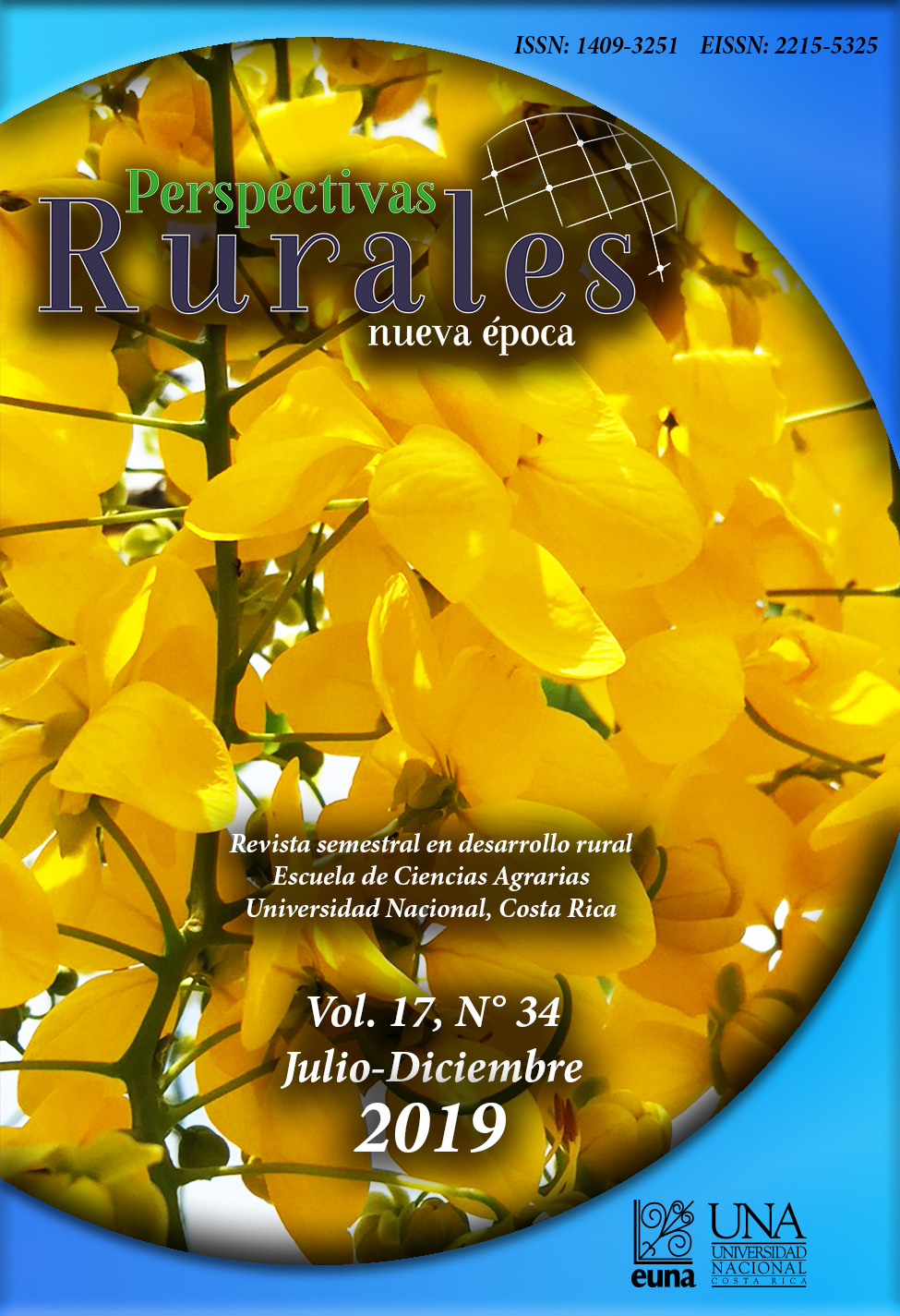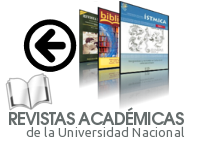América traumatizada: Proponiendo la agricultura “social” para mejorar la salud
DOI:
https://doi.org/10.15359/prne.17-34.7Palabras clave:
Salud ambiental y humana, servicios ecosistémicos, valor agregadoResumen
La violencia y exclusión traumatizan a millones de personas, para cuyo alivio el contacto con los paisajes relajantes y biodiversos, plantas, animales, suelos, agua y aire limpios puede ayudar. La agricultura social, promovida por la FAO, atiende e incluye a personas con vulnerabilidades físicas o psicológicas, mejorando su salud y autoestima, particularmente en granjas sin agroquímicos, poco mecanizadas, con bosques que oxigenen el aire y reduzcan catástrofes como las inundaciones y deslizamientos de tierra. Usando métodos ecológicos y sociológicos sencillos se puede cuantificar la calidad ambiental y de servicios a las personas vulnerables en las granjas, lo cual da criterios de remuneración extra a los servicios de agricultura social y los alimentos que esta genere mediante sellos de comercio justo y agricultura sustentable. Por la fragilidad de sus ecosistemas y riesgos de pérdidas de fertilidad del suelo, alta biodiversidad, alta variedad de pueblos y tradiciones indígenas, los Alpes y su agricultura social se asemejan a amplias zonas de América Latina. Por lo antedicho, el fomento de la agricultura social en nuestro continente no implica una imitación impertinente de prácticas foráneas, sino una posibilidad de agregar valor a las fincas mejorando, a la vez, la salud de personas traumatizadas y vulnerables.
Referencias
Ardila, J. (2010). Extensión rural para el desarrollo de la agricultura y la seguridad alimentaria: Aspectos conceptuales, situación y una visión de futuro (N.o IICA C20-31). Instituto Interamericano de Cooperación para la Agricultura -IICA.
Begon, M., Townsend, C. R. y Harper, J. L. (2009). Ecology from individuals to ecosystems. Wiley. Malden.
Bello, M. y Rangel, M. (2002). La equidad y la exclusión de los pueblos indígenas y afrodescendientes en América Latina y el Caribe. Revista de la CEPAL, 76, 39-54.
BFW –Bundesforschungszentrum für Wald (Centro austríaco de investigaciones forestales). (2014). Green care Wald. https://bfw.ac.at/cms_stamm/050/PDF/broschuere_greencare_link_neu.pdf.
Bermúdez Ledesma, L. M., Correa Escobar, J. C., Ortega Oliveros, A. M. y Vélez Galeano, C. P. (1997). Granja integral autosuficiente: Calidad de vida para el joven con retardo mental moderado. Universidad de Antioquia. Medellín, Colombia.
Cantú, C. (2006). Compendio de historia universal. http://www.biblioteca.org.ar/libros/132404.pdf.
Ceccon, E. (2003). Los bosques ribereños y la restauración y conservación de las cuencas hidrográficas. Ciencias 72, 46-53.
CEPAL –Comisión Económica Para América Latina. (2018). América Latina y el Caribe (23 países): Femicidio o feminicidio, último año disponible (en número absoluto y tasa por cada 100.000 mujeres). https://oig.cepal.org/es/indicadores/feminicidio.
Chave, J., Andalo, C., Brown, S., Cairns, M. A., Chambers, J. Q., Eamus, D., Fölster, H., Fromard, F., Higuchi, N., Kira, T., Lescure, J.-P., Nelson, B. W., Ogawa, H., Puig, H., Riéra, B. y Yakamura, T. (2005). Tree allometry and improved estimation of carbon stocks and balance in tropical forests. Oecologia, 145(1), 87-99.
Chaverri-Polini, A. (1998). Las montañas, la diversidad biológica y su conservación. Mountains, biodiversity and conservation. Unasylva, 49(195), 47-54.
Clemens, H. (2001). Nueva ruralidad y políticas agrarias en América Latina: Hacia una perspectiva de gobernabilidad para el desarrollo rural. Nueva Sociedad. 174. 66-80.
Departamento de Justicia de los EEUU –US Department of Justice. (2018a). Hate crime statistics (1996-2016). https://ucr.fbi.gov/ucr-publications#Hate
Departamento de Justicia de los EEUU –US Department of Justice. (2018b). Crime Index Offenses Reported (1996-2016). https://ucr.fbi.gov/ucr-publications
Di Iacovo, F. (2009). Social farming: dealing with communities rebuilding local economy. Journal of Farm Management, 13(7), 1-8.
Donovan, G. H., Butry, D. T., Michael, Y. L., Prestemon, J. P., Liebhold, A. M., Gatziolis, D. y Mao, M. Y. (2013). The relationship between trees and human health: evidence from the spread of the emerald ash borer. American Journal of Preventive Medicine, 44(2), 139-145.
Duruibe, J. O., Ogwuegbu, M. O. C., Egwurugwu, J. N. (2007). Heavy metal pollution and human biotoxic effects. International Journal of Physical Sciences, 2(5), 112-118.
Elings, M. y Hassink, J. (2006). Farming for health in the Netherlands. En J. Hassink y M. van Dijk (Eds.), Farming for Health (pp. 163-179). Springer.
Engle, N. L. (2011). Adaptive capacity and its assessment. Global Environmental Change, 21(2), 647–656.
Etchevers Barra, J. D. (1999). Técnicas de diagnóstico útiles en la medición de la fertilidad del suelo y el estado nutrimental de los cultivos. Terra Latinoamericana, 17(3), 209-219.
FAO –Organización de Naciones Unidas para la Agricultura y la Alimentación. (2014). The implications of social farming for rural poverty reduction. FAO.
FAO –Organización de Naciones Unidas para la Agricultura y la Alimentación. (2012). La extensión rural y su rol como promotora de procesos de innovación. http://www.fao.org/family-farming/detail/es/c/337960/
Fazzi, L. (2011). Social Co-operatives and social farming in Italy. Sociologia Ruralis, 51(2), 119-136.
Fournier Facio, M. V. (2000). Violencia y juventud en América Latina. Nueva Sociedad. 167, 147-156.
Fuentes Acuña, N. R. y Marchant, C. (2016). ¿Contribuyen las prácticas agroecológicas a la sustentabilidad de la agricultura familiar de montaña? El caso de Curarrehue, región de la Araucanía, Chile. Cuadernos de Desarrollo Rural, 13(78), 35-66.
Garrido-Pérez, E. I. y Sidali, K. L. (2016). Los niveles de organización ecológica: Una guía para administrar los recursos naturales y culturales. Investigación y Pensamiento Crítico, 4(2), 95-114.
González, C. G., Badia Perpinyà, A., Tulla i Pujol, A. F., Vera Martin, A. y Valldeperas Belmonte, N. (2013). L’agricultura social. Aproximació conceptual i dinàmica en el context europeu. Revista Bibliográfica de Geografía y Ciencias Sociales, 8(10046).
GCÖ –Green Care Österreich. (2017). Soziale Innovation für die Land- und Forstwirtschaft. Green Care Österreich.
Guirado, C., Valldeperas, N., Tulla, A. F., Sendra, L., Badia, A., Evard, C., Cebollada, À., Espluga, J., Pallarès, I. y Vera, A. (2017). Social farming in Catalonia: rural local development, employment opportunities and empowerment for people at risk of social exclusion. Journal of Rural Studies, 56, 180-197.
Hanski, I., von Hertzen, L., Fyhrquist, N., Koskinen, K., Torppa, K., Laatikainen, T., Karisola, P., Auvinen, P., Paulin, L., Mäkelä, M. J., Vartiainen, E., Kosunen, T. U., Alenius, H. y Haahtela, T. (2012). Environmental biodiversity, human microbiota, and allergy are interrelated. Proceedings of the National Academy of Sciences, 109(21), 8334-8339.
Herrera, F. (2012). La evolución de las demandas indígenas y las respuestas del Estado en Panamá. Quaderns-e, 17(1), 44-59.
Hickey, B. (2008). Lothlorien community: a holistic approach to recovery from mental health problems. Therapeutic Communities, 29(3), 261-273.
Hobsbawm, E. (1998). Historia del siglo XX. Grijalbo Mondadori.
Hochgruber-Kuenzer. (2018). Soziale Landwirtschaft wird in Südtirol bereits umgesetzt. ,http://www.maria-kuenzer.com/presse/soziale+landwirtschaft+wird+in+suedtirol+bereits+umgesetzt.html
Huemer, P. (2012). Langzeitmonitoring der Schmetterlingsfauna (Lepidoptera) in Waldstandorten Südtirols (IT01 Ritten und IT02 Montiggl). Forest Observer 6, 5-74.
Kaplan, R. (2001). The nature of the view from home: Psychological benefits. Environment and behavior 33(4), 507-542.
Kassam, K. A. S., Baumflek, M., Ruelle, M., y Wilson, N. (2011). Human ecology of vulnerability, resilience and adaptation: case studies of Climate Change from high latitudes and altitudes. En Kheradmand, H. y Blanco, J. (Eds.), Climate Change - Socioeconomic Effects (pp. 217-236). Intec Open.
Kernstock, P. y Prop, N. (2015). Wegweiser zum zertifizierten Green Care-Bauernhof. Green Care Österreich.
King, K. F. S. (1987). The history of Agroforestry. En H. A. Steppler y P. K. R. Nair (Eds.), Agroforestry: a decade of development (pp. 3-13). World Agroforestry -ICRAF.
Krebs, C. J. (1999). Ecological methodology. Harper & Row.
Lanfranchi, M. y Giannetto, C. (2014). Sustainable development in rural areas: the new model of social farming. Calitatea, 15(S1), 219-223.
Lattes, A. E. (2001). Población urbana y urbanización en América Latina. En F. Carrión (Ed.), La ciudad construida (pp.49-76). FLACSO.
Legge n. 141. (18 agosto 2015). Disposizione in materia di agricoltura sociale (15G00155). LEGGE n. 141. http://www.gazzettaufficiale.it/eli/id/2015/09/08/15G00155/sg
Leslie, H. M. y McLeod, K. L. (2007). Confronting the challenges of implementing marine ecosystem-based management. Frontiers in Ecology and the Environment, 5, 540–548.
Levy B. y Sidel V. (2008). War and Public Health. Oxford.
Manson, R. H. (2004). Los servicios hidrológicos y la conservación de los bosques en México. Madera y bosques, 10(1), 3-20.
Maurer, K., Weyand, A., Fischer, M. y Stöcklin, J. (2006). Old cultural traditions, in addition to land use and topography, are shaping plant diversity of grasslands in the Alps. Biological Conservation, 130(3), 438-446.
MEA -Millennium Ecosystem Assessment. (2005). Ecosystems and human well-being: synthesis. Island.
Minsburg, N. (1999). Transnacionalización, crisis y papel del Fondo Monetario Internacional y del Banco Mundial. En A. A. Borón, J. C. Gambina y N. Minsburg (Eds.), Tiempos violentos neoliberalismo, globalización y desigualdad en América Latina (pp. 4-24). CLACSO http://biblioteca.clacso.edu.ar/clacso/se/20100614032217/2minsburg.pdf
Ownby, D. R., Johnson, C. C. y Peterson, E. L. (2002). Exposure to dogs and cats in the first year of life and risk of allergic sensitization at 6 to 7 years of age. Jama, 288(8), 963-972.
Perrault-Archambault, M. y Coomes, O. T. (2008). Distribution of agrobiodiversity in home gardens along the Corrientes river, Peruvian Amazon. Economic Botany, 62(2), 109.
Prefectura Guayas. (2018). Centro de equinoterapia. http://www.guayas.gob.ec/equinoterapia/.
Rappe, E. y Evers, A. M. (2001). The meaning of growing plants: Contributions to the elderly living in sheltered housing. Hort Technology, 11(2), 268-272.
Russell, R., Guerry, A.D., Balvanera, P., Gould, R.K., Basurto, X., Chan, K. M., Klain, S., Levine, J. y Tam, J. (2013). Humans and nature: how knowing and experiencing nature affect well-being. Annual Review of Environment and Resources, 38, 473-502.
Schuler, Y. (2007). The farm as a special environment for children with learning disabilities. En J. Dessein (Ed.), Farming for Health -Proceedings of the Community of Practice Farming for Health (pp. 123-133). Community of Practice Farming for Health.
Serbin, A. (2007). Paz, conflicto y sociedad civil en América Latina y el Caribe. Icaria.
Simoncini, R. (2011). Governance objectives and instruments, ecosystem management and biodiversity conservation: the Chianti case study. Regional Environmental Change, 11, 29-44.
Smit, B. y Wandel, J. (2006). Adaptation, adaptive capacity and vulnerability. Global Environmental Change, 16(3), 282–292.
Stacul, J. (2018). The bounded field: localism and local identity in an Italian Alpine valley (Vol. 18). Berghahn.
Takano, T., Nakamura, K. y Watanabe, M. (2002). Urban residential environments and senior citizens’ longevity in megacity areas: the importance of walkable green spaces. Journal of Epidemiology & Community Health, 56(12), 913-918.
Thomas. K., Hardy, R. D., Lazrus, H., Mendez, M., Orlove, B., Rivera-Collazo, I., Roberts, J.T., Rockman, M. y Warner, B. P., Winthrop, R. (2019). Explaining differential vulnerability to climate change: a social science review. Wiley interdisciplinary reviews: Climate change, 10(2), e565.
Toledo, V. M., Barrera-Bassols, N., García-Frapolli, E. y Alarcón-Chaires, P. (2008). Uso múltiple y biodiversidad entre los mayas yucatecos (México). Interciencia, 33(5), 345-352.
Tulla, A. F., Vera, A., Valldeperas, N. y Guirado, C. (2017). New approaches to sustainable rural development: Social farming as an opportunity in Europe? Human Geographies, 11(1), 25-40.
van Elsen, T. (2010). Soziale Landwirtschaft Perspektiven sozialer Arbeit auf landwirtschaftlichen Betrieben. Landberichte. Sozialwissenschaftliches Journal, 13, 49-66.
Vanderveen, A., de Laat, P., Dominicus, M. y Mohammadi, M. (2015). Integral accessibility: a matter of social inclusion. Documento presentado en “The 7th International Conference of SuDBE2015”. Reading, Reino Unido.
von Ruette, J., Lehmann, P. y Or, D. (2016). Linking rainfall-induced landslides with predictions of debris flow runout distances. Landslides, 13(5), 1097-1107.
Publicado
Cómo citar
Número
Sección
Licencia
![]()
Revista Perspectivas Rurales. Nueva Época se encuentra bajo una licencia Creative Commons Reconocimiento-NoComercial-CompartirIgual 4.0 Internacional License.
Creado a partir de la obra en http://www.revistas.una.ac.cr/index.php/perspectivasrurales
Los autores/as que publiquen en esta revista aceptan las siguientes condiciones:
- Los autores/as conservan los derechos de autor y ceden a la revista el derecho de la primera publicación, con el trabajo registrado con la Licencia Creative Commons Atribución-NoComercial-CompartirIgual 4.0 Internacional, que permite a terceros utilizar lo publicado siempre que mencionen la autoría del trabajo y a la primera publicación en esta revista.
- Los autores/as pueden realizar otros acuerdos contractuales independientes y adicionales para la distribución no exclusiva de la versión del artículo publicado en esta revista (p. ej., incluirlo en un repositorio institucional o publicarlo en un libro) siempre que indiquen claramente que el trabajo se publicó por primera vez en esta revista.
- Se permite y recomienda a los autores/as a publicar su trabajo en Internet (por ejemplo en páginas institucionales o personales) antes y durante el proceso de revisión y publicación, ya que puede conducir a intercambios productivos y a una mayor y más rápida difusión del trabajo publicado.






 :
: 
